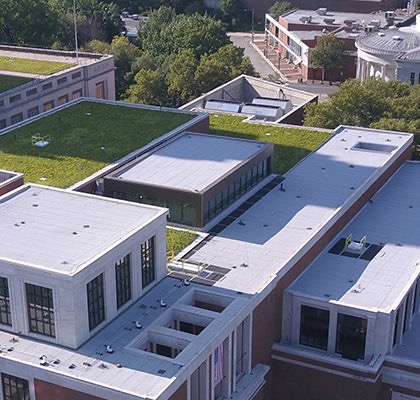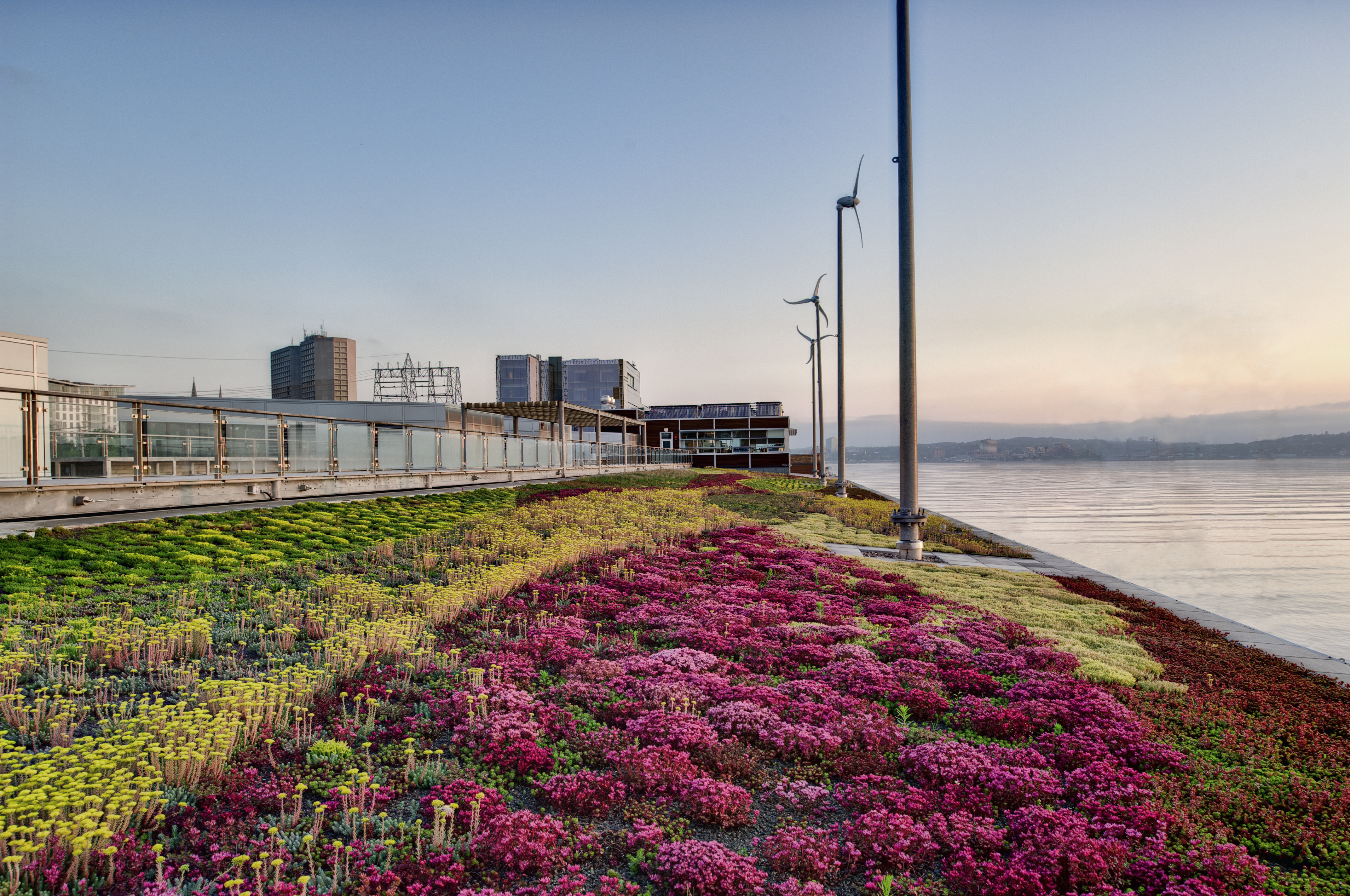
Photo courtesy of SOPREMA
Sustainability goes well beyond traditional considerations like regulatory compliance and reducing volatile organic compounds. Green roof installation at Halifax Seaport Farmer’s Market.
Setting the Playing Field: Defining Sustainability for Tomorrow
The National Environmental Policy Act of 1969 committed the United States to sustainability, declaring it a national policy “to create and maintain conditions under which humans and nature can exist in productive harmony, that permit fulfilling the social, economic and other requirements of present and future generations.”1 The original impetus toward sustainability was motivated by a public desire for a higher quality of life and well-being, improved human health, and long-term protection of ecosystems.2 Recognition of the adverse effects of pollutants, pesticides, and chemicals on humans and the environment helped spur the growth of sustainable policy and products.
Sustainability: An Evolving Quest
The quest for sustainability that began in the 1960’s has accelerated considerably, and has radically affected all aspects of life, including the building industry. The changes taking place within the design and construction industry today are dramatic and have happened over a very short time. This includes the evolution of the concept of sustainability itself.
In the past, products and systems considered to be sustainable had a single focus, such as recyclability or thermal efficiency. However, as codes and policies transform the built environment, the sustainability of a material or building now is drawn from its total lifecycle impact. The implications of each product, from material extraction, to manufacturing and production, into its construction and life in the building, and beyond to the product’s eventual reuse, demolition, or disposal, are measured. The sum of these calculations create an emissions profile throughout a system’s or product’s life.
Sustainability for the future hangs on three main tenets: to minimize the depletion of natural resources in order to maintain an ecological balance; to conserve energy by improving thermal efficiency; and to extend a building’s lifespan by improving long-term performance. The architect and professional design team are now responsible evaluating the health, durability, environmental safety, total lifespan, and potential for repurpose of each product they select.
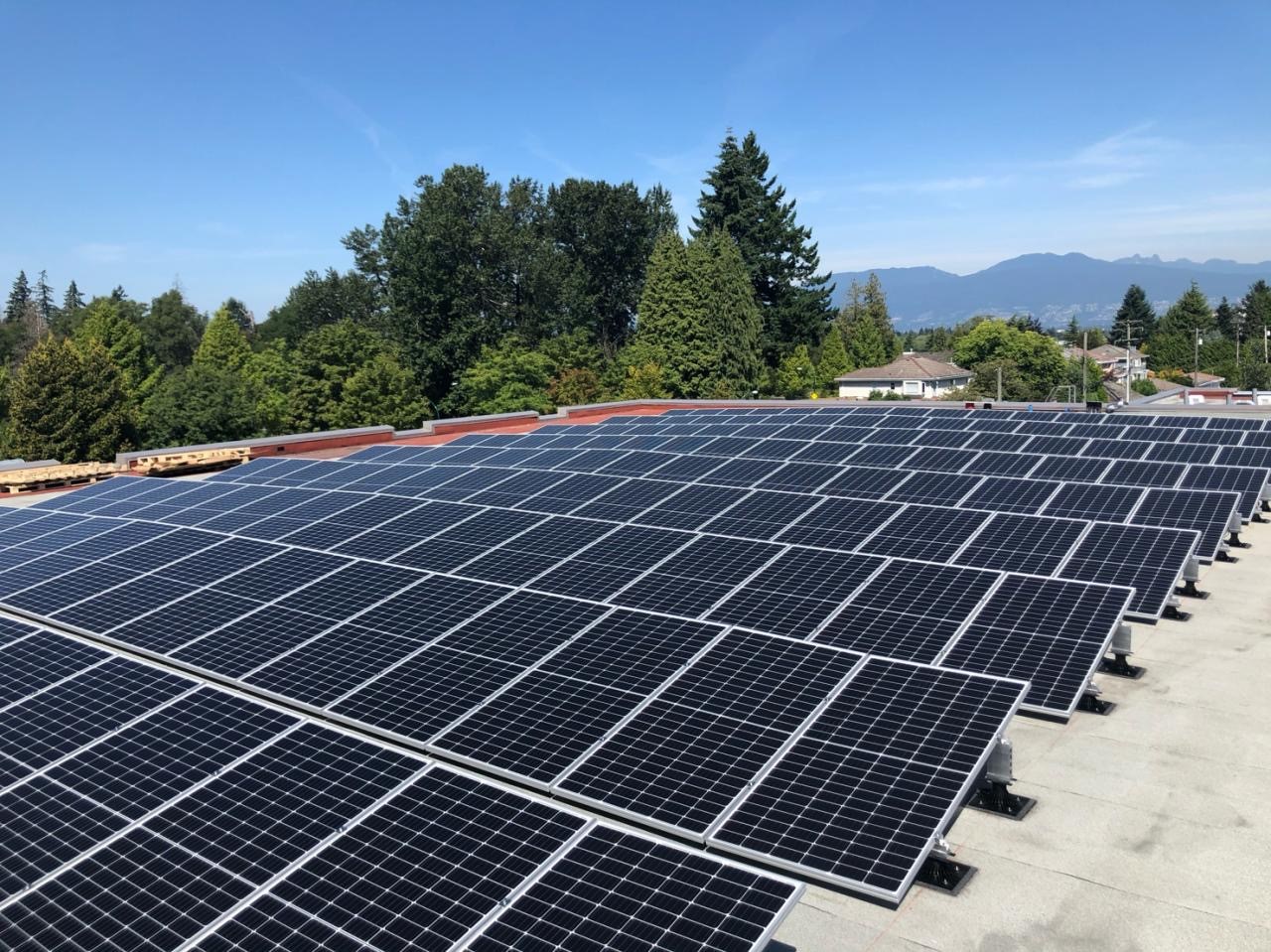
Photo courtesy of SOPREMA
Commercial roofs can not only enhance a building’s sustainability through material selection, they can also host additional efficiency measures such as photovoltaic installations.
Cast in this light, sustainability is now truly concerned about long-term impacts. Thus, sustainability has become intertwined with the concept of resilience. A product’s sustainability will be measured out over time. Climate change and associated extreme weather events and changing precipitation patterns need to be factored in for a sustainable product, as they mean additional risk to businesses, organizations, and society. To respond to this change and its side effects, designers must look beyond sustainable design to strategies that enhance resilience—designers and engineers must respond by considering how it will affect the resilience of projects in decades to come. Products and systems need the ability to withstand hazards and recover quickly.
A product or material’s carbon footprint is derived from two phases: operational carbon and embodied carbon. Operational carbon is carbon emitted during the in-use phase of a building and includes the use, management, and maintenance of the product, as well as energy and water consumption. Embodied carbon accounts for all other emissions of that product, including raw materials extraction, the processing, shipping, manufacturing of product, construction, demolition, and ultimate disposal.
Today, sustainability of products is best comprehended via the measurements and impacts of material health and environmental impact.
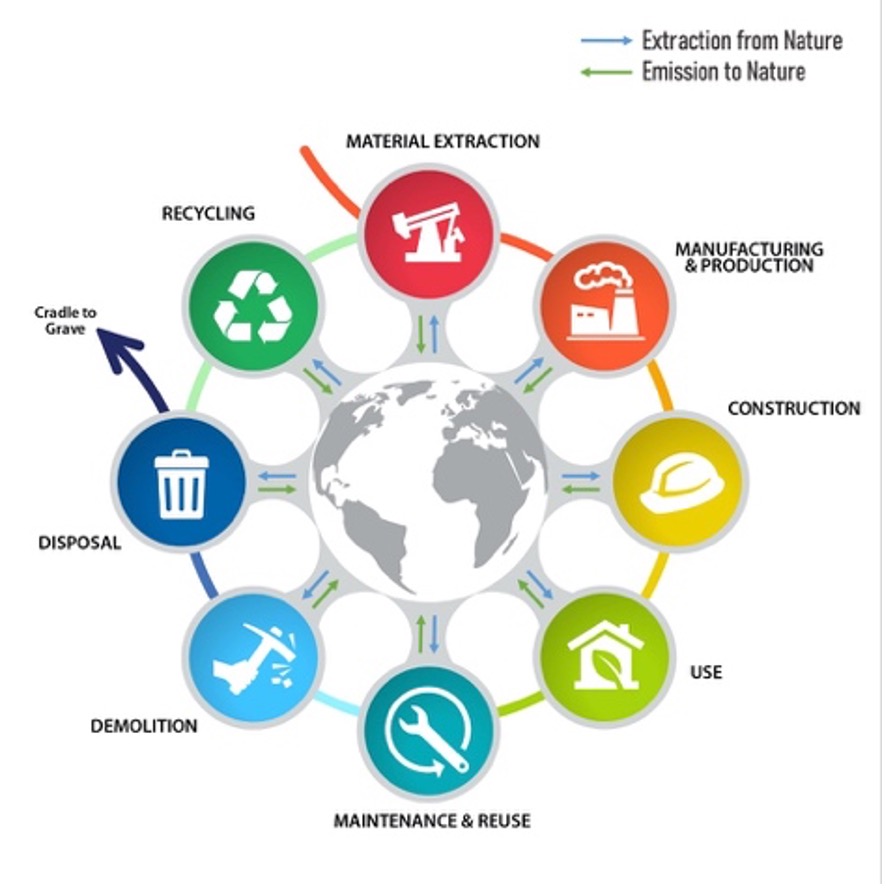
Image courtesy of SOPREMA
Sustainability and lifecycle impact map for products. To provide a true profile of total environmental impact, carbon emissions should be calculated for a material’s entire lifecycle.
This shift in definition is reflected by recent policy trends. Municipalities, states, and federal standards are pushing new building performance standards. In Boston, building emission standards taking effect in 2025 will set limits on new buildings over 35,000 gross square feet. For example, new multifamily construction must have emissions under 4.1 kgCO2e/SF/yr. The New York City Department of Buildings released an advisory board report with recommendations for city officials on implementing Local Law 97, which adds GHG emission limits for most buildings larger than 25,000 square feet starting in 2024. Even stricter standards would take effect in 2030 under the law. The White House issued a New Federal Standard with a goal of 50 percent building emissions reduction by 2032, based on a 2008 benchmark.
Addressing Embodied Emissions
Largely overlooked historically, embodied carbon emissions account for around 11 percent of all carbon emissions worldwide.3 Embodied carbon represents a new challenge for the built environment. The World Green Building Council estimates that the built sector is responsible for 39 percent of global carbon emissions.
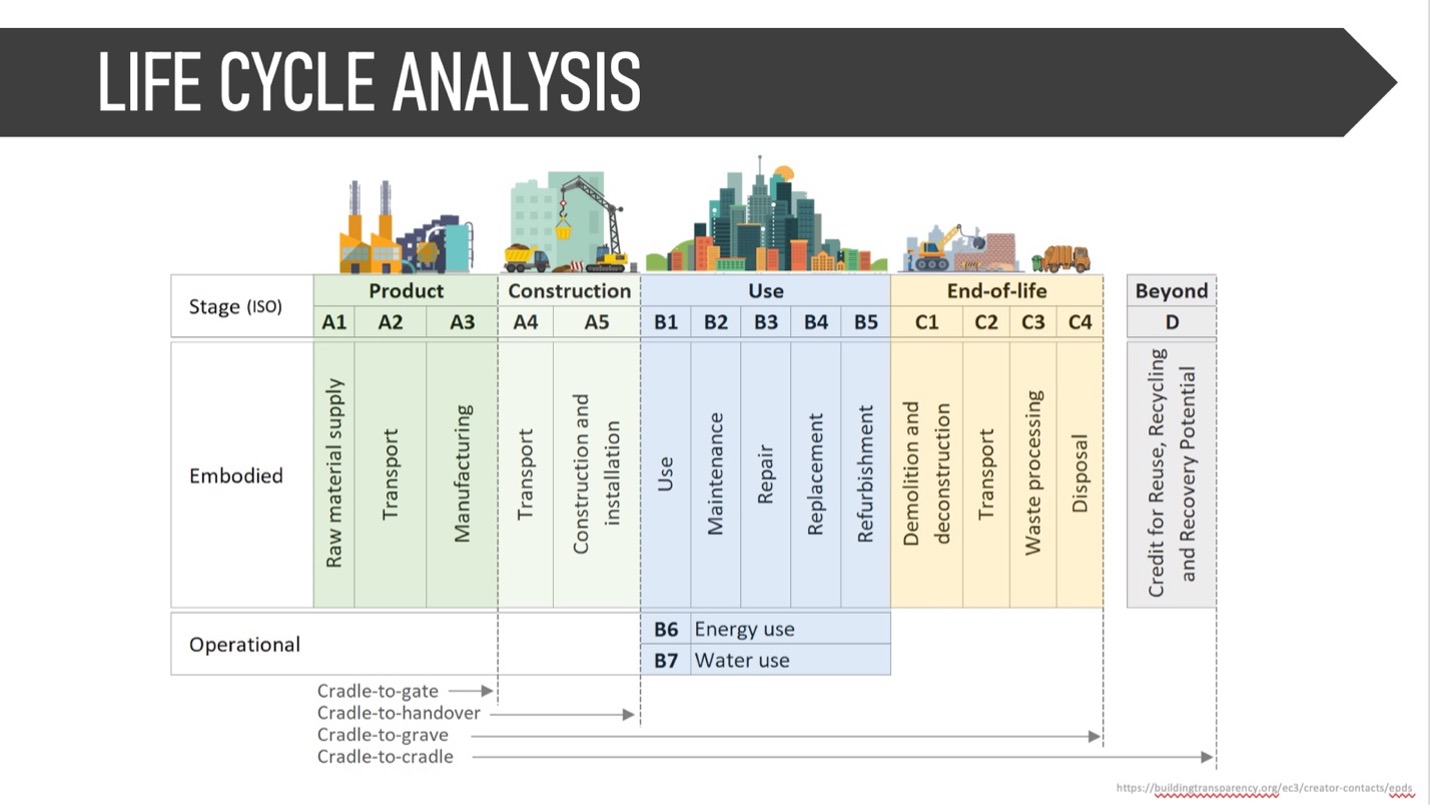
Image courtesy of SOPREMA
The diagram highlights the different stages and corresponding terminology for LCA. Adding embodied carbon and operational carbon gives the total or whole life carbon of a product or material.
Adding together embodied carbon and operational carbon gives the total or whole life carbon of a product or material. While knowing the complete sustainability profile is a powerful asset, how can this information be captured to impact design? Once embodied carbon is measured, how can that information be made useful?
Equipping the Professional: EPDs
An EPD is an Environmental Product Declaration. It is a third-party verified document that communicates the life-cycle environmental impacts of products. The document can be based on one product or a collection of products that are functionally equivalent. An EPD is independently verified and registered document that communicates transparent and comparable information about the life-cycle environmental impacts of products. Data included describes, at a minimum, the product’s performance characteristics, provides a description of the product’s manufacturing processes, lays out calculation criteria, and discloses environmental impacts from raw material supply, transport, and manufacturing life-cycle stages.
Equipping the Professional: HPDs
Health Product Declarations, or HPDs, report product contents and associated health information, and are focused on the chemical composition of materials. The HPD Collaborative was created and is run by a coalition of building industry architects, designers, and consultants. The Collaborative developed the HPD Open Standard to provide uniform and consistent reporting.
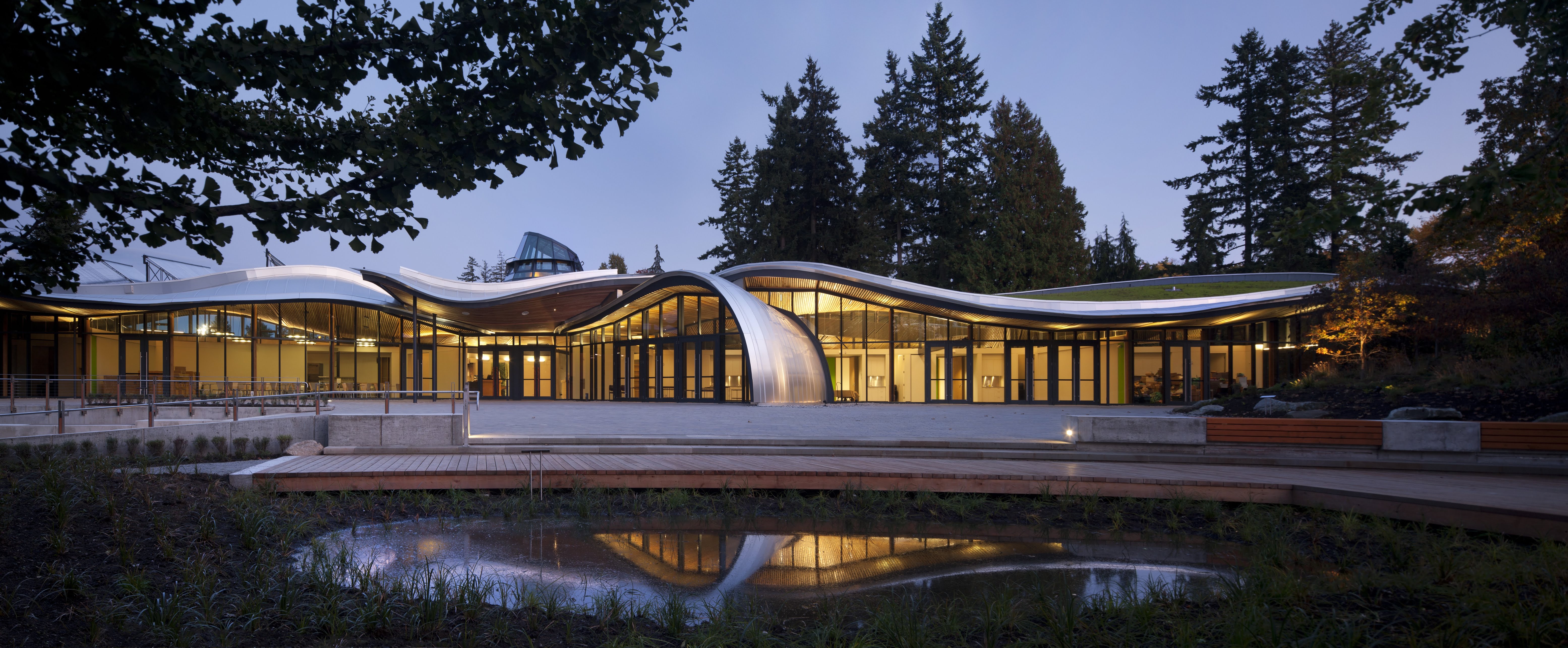
Image courtesy of SOPREMA
To manage environmental factors appropriately, the design professional needs tools to confidently measure those factors. Jardins Van Dussen.
Equipping the Professional: Evaluating Building Emissions
Just as an EPD allows for product transparency, there are tools that allow building emissions to be compared at the construction material and project scale. The EC3 Embodied Construction Calculator allows owners and green building certification programs to assess supply chain emissions. The tool allows embodied carbon limits and reductions to be set, establishing an optimum embodied carbon level and highlighting available reductions for the project. The Athena Sustainable Materials Institute Impact Estimator, first released in 2002, provides a cradle-to-grave life cycle inventory profile for an entire building. Users enter basic design information, such as bay size and loads, and the software calculates the bill of materials and the associated environmental impacts. Athena is one of several whole building LCA tool that can be used to explore the environmental footprint of different material choices and core-and-shell options. This software can model over 1200 structural and envelope assembly combinations for quick and easy comparison and can be uploaded through Building Information Modeling (BIM).
There are many additional resources available to aid in product evaluation. A few key ones include The Mindful Materials with its Common Materials Framework which is a coalition-built framework designed to organize and align sustainability data, so that it can be consistent across platforms, pledges, and organizations. Another is the Sustainable Minds® Transparency Catalog which provides help by simplifying the delivery of product transparency information. Products are organized by CSI category offering the ability to compare information by manufacturer.
Cradle to Cradle Certified® is an international certification focusing on the health of a product. It is a leading multi-attribute standard used globally and across industries to innovate and optimize materials and products according to the world’s most advanced science-based measures. The Cradle to Cradle Certified® Product Standard provides the framework to assess the safety, circularity and responsibility of materials and products across five categories of sustainability performance: material health, product circularity, clean air and climate protection, water and soil stewardship, social fairness.
UL GREENGUARD is a certification for low-VOC products. It helps demonstrate both compliance with key chemical emission standards and the manufacturer’s commitment to healthier indoor environments. Numerous building programs, standards, and specifications worldwide recognize and refer to the UL GREENGUARD Certification program.
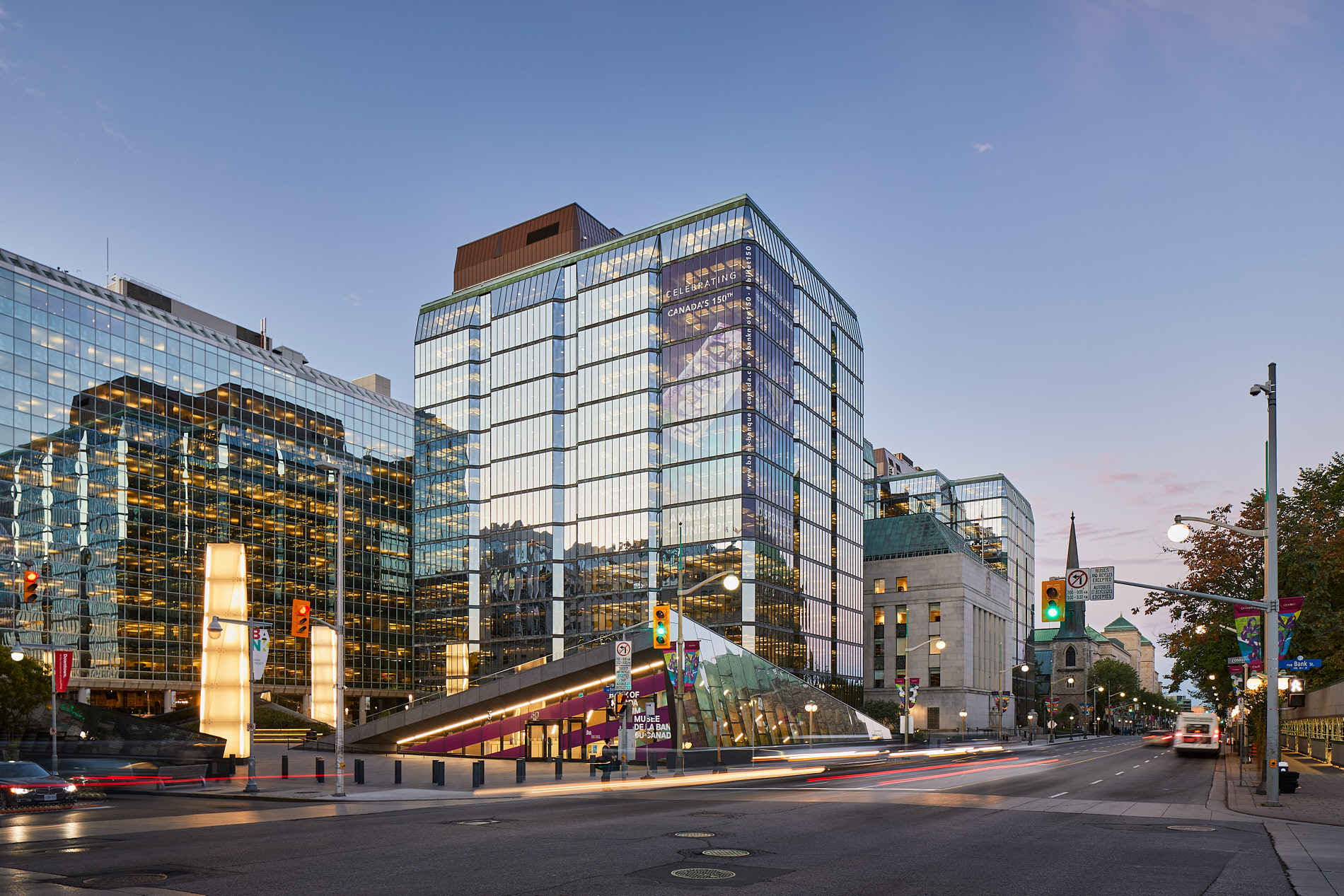
Photo courtesy of SOPREMA
Designers must look to strategies that respond to the disruption of life as we know it by considering how it will affect the resilience of projects in decades to come. Bank of Canada.
Choosing Sustainable and Resilient Roofing Materials to Contribute to Design Goals
Thoughtfully selected commercial roofing can enhance the resilience and sustainability of the built environment. The best of these systems increases the service life of buildings, increases the overall performance of buildings, increases the resilience of buildings, and ensures the health and comfort of occupants.
Resiliency and durability are building blocks for sustainability. The roof assembly should be designed to deal with natural events, with the intent that any damage would require minimum repairs or disruption to the operations of the building. Redundancy of systems is a key component in this strategy. Additionally, building codes have to be regarded as the minimum. Designs that exceed those codes can provide increased resilience, keeping the structure ahead of performance requirements.
Roofing Contributions to Sustainable Design
Commercial roofing offers practical contributions and attributes to sustainable design. These include membrane durability, smog or pollution reduction strategies, energy efficiencies, insulation with GHG reduction, and alternate roof designs with vegetated roof systems, and stormwater management.

Photo courtesy of SOPREMA
A resilient roof is designed to deal with natural events with the intent that any damage requires minimum repairs or disruption to the operations of the building.
Durability and Resilience
Modified Bitumen systems have been used globally for over 50 years in the roofing and waterproofing industry with proven performance. With the longest lasting performance of all products, modified bitumen systems offer demonstrable durability. While other synthetic roofing technologies and systems have evolved in that time, modified bitumen systems continue to maintain a long-standing reputation for durability and longevity. Modified bitumen roofs today have evolved with significant improvements in application and technologies. Their longer service life and less waste create less environmental impact. Single-ply roofing, with a depth of 60 or 80 mls, has an expected service life of 15 to 20 years where modified bitumen roofs, at 240 mls, have an expected service life of 30 years or greater. The longer the life of the roof, the less carbon emissions created with the replacing the roof and avoiding landfill waste. A long lasting roof leads to less waste.
An additional benefit to increase the sustainability attribute is the fact that a modified bitumen roof can be overlayed upwards of two times depending on local codes. The European Waterproofing Association (EWA) published an Environmental Product Declaration (EPD) for flexible bitumen sheets. This EPD reports in detail the environmental performance for these systems. The EWA concluded that properly designed, installed, and maintained modified bitumen systems can last greater than 35 years, and, where replacement roofs can be installed right over the existing roof for a total of two times, the roof provides upwards of a 105-year service life. The product is also recoverable.
A final point to highlight with modified bitumen roofs is their proven resilience in severe weather—considering the increasing severe weather events. In 2022, the U.S. experienced 18 separate weather and climate disasters costing at least 1 billion dollars.4 That number puts 2022 into a three-way tie with 2017 and 2011 for the third-highest number of billion-dollar disasters in a calendar year, behind the 22 events in 2020 and the 20 events in 2021.5 Both SBS and APP modified bitumen membranes as well as liquid applied membranes were found to be best at resisting damage, as noted in the Federal Emergency Management Agency (FEMA) and the National Institute of Standards and Technology (NIST) guidelines.6
When it comes to the protection of a building, the roof is the first line of defense against severe weather. There are few more common weather events that are more devastating to a roofing system than hail. FM Global is one of the most prominent property insurance companies and specializes in loss prevention and testing. FM Global has designated hail zones in the United States, classifying each zone based on the size of hail. These zones are used when designing, specifying and constructing roof systems to ensure they meet the criteria to withstand impacts from the designated hail size. The geographic areas have expanded year-over-year according to FM Global. The most stringent rating is for Very Severe Hail (VSH), where hail stones greater than 2 inches may occur. The roof assemblies undergo the most stringent testing to obtain VSH approval and are a testament to the proven resilience and durability. Modified bitumen systems are the most frequently approved roofs under VSH criteria.

Photo courtesy of SOPREMA
As cities densify, air quality is negatively impacted. Roofs using photocatalytic coatings harbor granules that react with UV light to reduce air pollutants. Twenty thousand square feet of treated roofs can offset 8,000 miles of car emissions annually or equate to 120 trees.
Pollution
Twenty-five major cities are failing to meet federal standards for air quality. The American Lung Association’s “State of the Air” 2023 report finds that after decades of progress on cleaning up sources of air pollution, nearly 36 percent of Americans—119.6 million people—still live in places with failing grades for unhealthy levels of ozone or particle pollution.7 The number of people living in counties with failing grades for daily spikes in deadly particle pollution was 63.7 million, the most ever reported under the current national standard. 8
Photocatalytic coatings, the latest in technology, are entering the picture to help roofs with a demonstrable performance to provide a solution. These coatings come as granules placed on the cap sheet of a modified bitumen roof. The photocatalytic coating reacts with ultra-violet (UV) light to reduce air pollutants. A team at 3M designed the photocatalytic granules decades ago in pursuit of ways to remove algae and its associated black streaks from rooftops. The granules work through photosensitization, a process by which a photochemical alteration occurs in one molecular entity as a result of initial absorption of radiation by another molecular entity. The most powerful advanced oxidation systems are based on the generation of hydroxyl radicals. The hydroxyl radical is an extremely powerful oxidation agent. Utilizing the strong oxidation strength of hydroxyl radicals, photocatalytic oxidation can effectively disinfect, deodorize, and purify air, water, and different surface areas. It can prevent accumulation of smoke and soil, pollen, bacteria, virus and harmful gases, as well as seize the free bacteria in the air by a filtering percentage of 99.9 percent with the help of the highly oxidizing effect of the photocatalyst. Photocatalytic coatings are also self-cleaning. In essence, when sunlight hits the granules, the ultraviolet rays convert captured polluting gases to safe, water-soluble ions that wash away when it rains.
Lawrence Berkeley National Laboratory tested the technology, confirming the granules reduce nitrogen oxide levels. For every 500 square feet of roof covered in granules, the cleaning performance equates to that of 3 mature trees. A 20,000-square-foot roof offsets 8,000 miles of car emissions.
Energy Efficiency
The 2012 International Energy Conservation Code (IECC), which adopted ASHRAE Standard 90.1- 2010, increased the minimum thickness required for continuous insulation for most commercial wall assemblies in climate zones 3 through 8, or approximately 90 percent of the United States. The 2012 IECC also included specific, mandatory provisions for Air Barriers in Climate Zones 4-8. These requirements can be met through the use of approved materials, approved assemblies, or whole building air leakage testing (ASTM E779). Since 2009, the roofing industry has seen an R-10 increase in most of the states. The total minimum insulation thickness has increased from 3.5 inches (R-20) to 5.2 inches (R-30) in parts of over 40 states. The 2015 International Energy Conservation Code (IECC) is the driving force behind this movement, and currently more than 20 states have adopted the 2015 IECC, or a portion of its provisions, as their statewide energy code.
Insulation Impacts
As energy codes change, they have increased the amount of insulation and required R-value. However, insulation carries its own environmental impact. Until recently, HFC was the blowing agent of choice used for manufacturing rigid insulation and pressurized foams and adhesives. However, HFC has a high global warming potential (GWP) 1400 times that of 1kg CO2. A newer agent, HFO, carries a rating less than 1 GWP. For this reason, states have been changing regulations to outlaw products using HFC.
Those roofing insulation products produced using HFO as a blowing agent have reduced CO2 emissions by 99.8 percent. Thermal conductivity with HFO is 25 percent better, and shrinkage is minimized. Recycled content is another important advance, with some manufacturers having products that feature up to 70 percent recycled content.

Image courtesy of SOPREMA
Global warming potential environmental impact from different types of insulation. A significant amount of emissions come from manufacturing, as show in blue. Product data drawn from publicly available EPDs.
When comparing roofing insulation materials, most greenhouse gas (GHG) emissions are generated from product manufacturing and occur as embodied carbon. The emissions are generated during material extraction and manufacturing. Significant swings of environmental impact can be seen between four different manufacturers of extruded polystyrene (XPS) products. Having an EPD from a manufacturer allows for vital information about impacts incurred during material extraction and processing. Understanding specific product GHG emissions can translate, on a typical 10,000-square-foot roof, into a 25 to 30-ton difference of embodied carbon emissions between the product with the highest GHG and the product with the lowest. EPDs and material transparency provide design professionals with a powerful selection tool to minimize embodied carbon through product choice. Cellulose insulations have the lowest GWP generally, based on product EPDs, with open cell spray foam and certain XPS and EPS systems also having lower GWP.
Sealant and Adhesive Materials
Advances in sealants and adhesives also have been made. Environmentally friendly, low-VOC, and no-odor products can contribute to certifications on schools and healthcare projects while generally lowering a project’s environmental impact. A new technology, silyl-terminated poly ether, or STPE, offers a “do no harm” moisture cure product with ultra-low VOCs, and there are no isocyanates commonly found in PURs. This material is formulated for use in sealants, adhesives, weather resistant barriers (WRBs), and liquid applied waterproofing as well.
Cool Roof Performance
Cool roofing or reflective, white roofs have become common in many parts of the country and can offer energy efficiency benefits in some climate zones. Cool roofing, for better or worse, has virtually become a ‘de facto’ standard for many specifiers. A reflective roof can reduce the roof’s surface temperature by 40 to 60 degrees Fahrenheit, which in turn can reduce air-conditioning demand in certain climates and conditions. Cool roofs in ASHRAE climate zones 1-3 that are “under insulated” are an ideal fit. However, for climate zones 4-7, cool roofs can have a different return on investment (ROI), since there are typically more heating days than cooling. For these zones, data cautions that cool roofs may not be an automatic best fit, and should not become a ‘de facto’ standard. An initial study on the benefits of cool roof mandates was completed by ICF, an independent consulting firm with experience in climate change and data analysis. ICF undertook an analysis of existing data and previous studies on Urban Heat Islands (UHI), with specific focus on the measurable impacts of the roof albedo (albedo is the fraction of sunlight that is diffusely reflected by a body) of low-slope roofing. In certain arguments for the universal acceptance of cool roofs, even when energy efficiency gains were ruled out, the case was made that cool roofs had a positive impact on the UHI. ICF’s analysis of temperature data for cities with cool roof mandates found no discernable correlation between the imposition of cool roof mandates and a reduction in UHI.
To further inform the findings of this initial study, the ERA commissioned a companion literature review, working with the Department of Construction Science and Management at Clemson University. This literature review conducted a thorough investigation of published studies and models designed to understand the impact of membrane color on energy efficiency. The macro-level literature review investigated more than two thousand published articles. According to the Clemson researchers, this literature review exposed the reasons that there is no clear answer about the relationship of UHI and energy efficiency. First, the results of these studies varied because the impact of cool roofs is influenced by a range of factors such as roof type, insulation quantity and efficiency, climate, and location. The studies also varied in methods of data capture and analysis, reliance on simulation-based studies, and minimal data capture duration. Other factors potentially influencing varying outcomes included consideration of a “heat penalty” during the winter season and the interaction of different building heights. Additionally, there was no consistent comparison of the impact of the urban tree canopy, roof type, insulation thickness, hardscape, and asphalt paving surfaces. “In many instances”, according to Dr. Dhaval Gajjar, a primary researcher on the project, “more recent studies based their conclusions and recommendations on widely distributed prior studies, which now must be considered dated or incomplete information given more updated research.”9
Green Roofing Contributions
There is an increasing demand for green roofing. Demand for green, or vegetative, roofing systems in the U.S. is forecast to rise 5.1 percent per year to $207 million in 2025, with demand, measured by area, projected to reach 11.8 million square feet, according to Berkshire Hathaway’s Business Wire 2022 study.10 Additional factors cited that support this growth forecast include: the rising awareness of both the public and the private benefits of green roofs, such as reducing urban heat island effects and increasing local biodiversity while also lowering building utility costs; the expanding number of cities with green roofing mandates and/or incentive programs that promote property owners to install green roofs; the aesthetic appeal and recreational benefits of green space amenities; and the ability of green roofing systems to earn LEED credits.11 Green roofs and blue roofs, those roofs engineered for flow and water detention within a vegetated roof, have measurable benefits that include added amenity and usable space, cleaner air, roof protection, noise reduction, reduction in the heat island effect, more energy efficiency, and greater biodiversity. A green roof can also include a roof garden, solar or photovoltaic systems, and living areas like patios.
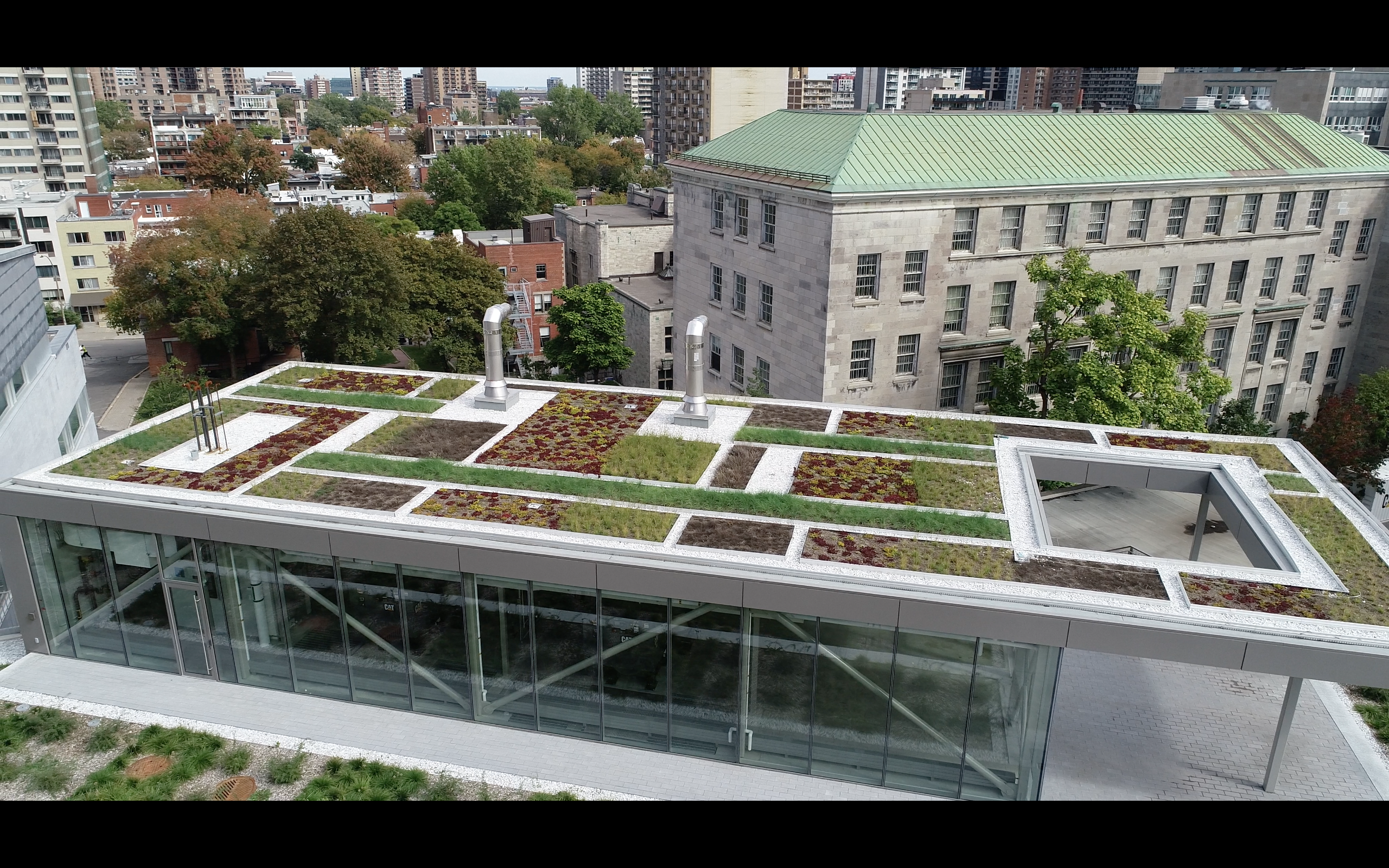
Photo courtesy of SOPREMA
Selecting a green roof brings a multitude of benefits, including noise and heat reduction, roof protection, cleaner air, biodiversity, and greater amenity and usable space.
In some markets, a design goal for vegetated roofs is to maximize nutrient removal and runoff volume reduction. By retaining and releasing water at a certain pace, blue roofs offer stormwater management. As runoff becomes an increasing concern for urbanized settings, many municipalities are giving credits to offset the costs for a blue roof.
Through either retention strategies, like cuspated drainage sheets or moisture mats, or detention methods, including drainage and storage cells, a blue roof can absorb up to 60 percent of small to medium size storm occurrence. The Virginia Stormwater Management Handbook 2013 states: “…a paradigm shift in the approach to managing runoff from land development projects… focusing primarily on reducing the volume of runoff on the site, rather than focusing on merely treating the pollution in the runoff. Runoff volume reduction accomplishes the full range of stormwater management goals more effectively and efficiently than in the past.”
Highlighting Stormwater and Roofs
In addition to aesthetic appeal and energy-savings, green roofing offers an excellent solution for mitigating storm water in urban environments. Most urban infrastructure is not designed to process all the rainwater it collects, especially when the majority of city surfaces are impermeable surfaces.
“Stormwater is only getting worse in terms of storm water management, and it’s being required more and more by not only major urban cities, but even secondary urban cities as well,” said Greg Raymond of SOPREMA.
Roxanne Miller, a landscape architect, horticulturist, and green roof specialist with SOPREMA, emphasizes that green roofs create the foremost environmental solution to stormwater management. Miller notes that green roofs which incorporate ‘blue,’ acting as a temporary storing system for rainwater, aid urban stormwater management capacity. When designed properly, a green roof can reduce the required size of a building cistern, absorb a percentage of collected rainwater, and ease the burden on urban infrastructure. There is an increasing emphasis in policy about roofing and mandating flow to drains in cities.
Eyes on the Prize: Understanding Certifications to Achieve Project Goals
Once project sustainability has been defined, certifications offer a toolset for making sustainable product decisions.
Industry Certifications
LEED®
LEED®, or Leadership in Energy and Environmental Design, is the most widely used green building rating system. LEED certification is a globally recognized symbol of sustainability achievement. LEED is for all building types and all building phases including new construction, interior fit outs, operations and maintenance, and core and shell.
LEED v4.0 and v4.1, beta version, have 9 different categories for certification. These versions are referred to below. LEED v5.0 will be released for comment in September 2023, with a final version released in 2024.
There are 5 categories where roofing can contribute under LEED v 4.0 and v4.1:
- Materials & Resources (MR)
- EPD’s, HPD’s, recycled content
- Environmental Quality (EQ)
- Low emitting materials, thermal performance
- Energy & Atmosphere (EA)
- Minimum energy / optimize energy
- Sustainable Sites (SS)
- Heat island reduction, rainwater management
- Innovation (IN)
- Significant, measurable environmental performance using a strategy not addressed in the LEED® rating system, new technologies.
LEED v4.0 Project Profile
Under LEED v4.0 there are multiple contributions possible for credits from commercial roofing. Added options can gain additional points depending on the attributes in the category.
LEED® Credit MRc2 (Building Product Disclosure & Optimization) – Environmental Product Declaration (EPD) – Achieve a minimum of 20 different permanently installed products from at least five different manufacturers that have EPD’s with at least a cradle-to-gate scope.
- Third-party verified product specific Type III EPD – 1 point
- Industry-wide (generic) Type III EPD – ½ point
LEED® MRc3 (Building Product Disclosure & Optimization) – Sourcing Raw Material/Recycle Content – Products have at least 25 percent, by cost, of the total value of permanently installed building products on project.
- Product that is extracted or sourced in responsible manner (Recycled content) – 1 point
- Includes Bio-based, Wood, or materials reuse
LEED® Credit MRc3 (Building Product Disclosure & Optimization) – Material Ingredients (HPD’s) Achieve a minimum of 20 different permanently installed products from at least five manufacturers that use the Health Product Declaration (HPD) or Declare (1000 ppm) to show chemical inventory of products. – 1 point
- Regional Multiplier – products sourced within 100 miles of the project site – 1 point
LEED® Credit SSc4 – Rainwater Management – Reduce runoff volume based on historical conditions.
- Use Vegetative Roof assembly (qualifying area 75 percent) – 1-2 points
LEED® Credit SSc5 – Heat Island Reduction (reduce thermal gradient differences due to impervious surface) Use either of the following:
- High Reflectance Roof (Cool Roof) – Low-slope Initial SRI 82 or 3 year aged SRI 64 – 1-2 points
- Vegetated Roof (qualifying area 75 percent) – 1-2 points
LEED® Credit EQc2 – Low emitting materials (Air quality) Low-VOC adhesives and sealants for roofing and building envelope are considered exterior products and are exempt from credit requirements except for schools and healthcare projects.
LEED® Credit IN (Innovation in Design) – Encourage innovative performance not in current rating system. Modified bitumen cap sheet surfaced with smog reducing granules. – 1-2 points

Photo courtesy of SOPREMA
Using materials that meet third party certifications offers added assurance that the product – its production, materials, and lifecycle – have been thoroughly examined. Hard Rock Atlantic City.
The Living Building Challenge
The Living Building Challenge (LBC) is a philosophy, advocacy tool, and certification program that addresses development at all scales, with the core underlying principle that buildings should mimic nature and natural systems. Toxic materials (Red List Chemicals) are not permitted on projects and LBC aims to eliminate their use. A flower metaphor is used to illustrate how all elements of the built environment are rooted in place.
Administered by the International Living Future Institute (ILFI), LBC is a certification program and a framework for manufacturers to create products that are healthy and free of toxins, socially responsible and respect the rights of workers, and net positive and beneficial for both people and the environment. There are three pathways to certification: Imperative, Petal, and Full Living Product Certification. The Petals of the Living Product Challenge have specific Imperatives that define the actions needed to achieve that Petal:
- Place (Responsible Place, Habitat Exchange, Living Economy Sourcing)
- Water (Water Footprint, Net Positive Water)
- Energy (Energy Footprint, Net Positive Energy)
- Health + Happiness (Red List, Transparent Material, Health, Human Thriving)
- Materials (Responsible Industry, Regenerative Materials, Net Positive Waste, Net Positive Carbon)
- Equity (Ethical Supply Chain, Equitable Investment, Just Organizations, Social Co-Benefits)
- Beauty (Inspiration + Education, Beauty + Spirit)
Commercial roofing can support the Materials petal. Manufacturers have to provide documentation that products used are Red List-free.
WELL Building Standard
The WELL Building Standard™ is an evidence-based system for measuring, certifying, and monitoring the performance of building features that impact health and wellbeing, and is also the world’s first building standard focused exclusively on human health and wellness. The standard is divided into 10 concepts: air, water, nourishment, light, movement, thermal comfort, sound, materials (specifically dealing with material transparency), mind, and community.
End notes
1National Academies of Sciences, Engineering, and Medicine. 2011. Sustainability and the U.S. EPA. Washington, DC: The National Academies Press.
2Hays, S.P. 1987. “Beauty, Health, and Permanence: Environmental Politics in the United States”, 1955-1985 (Studies in Environment and History). Cambridge: Cambridge University Press.
3“Towards zero-carbon building”. Thought Leadership. Climate 2020. World Green Building Council. Accessed June 14, 2023.
4“2022 U.S. billion-dollar weather and climate disasters in historical context”. Accessed June 15, 2023.
5Ibid.
6“Fact Sheet 3.3.2: Low-Slope Roofs.” Hurricane and Flood Mitigation Handbook for Public Facilities. Federal Emergency Management Agency. Accessed June 15, 2023.
7Key Findings. American Lung Association® State of the Air 2023. . Accessed June 15, 2023.
8Ibid.
9"ERA Recommends Updated Approach to Mitigate Urban Heat Island Impact". Accessed June 20, 2023.
10“United States Green (Vegetative) Roofing Market 2022-2030: Post-Pandemic Rebound in Commercial Building Construction to Drive Market Growth.” ResearchAndMarkets.com. June 20, 2022. Berkshire Hathaway. Accessed June 20, 2023.
11Ibid
As a sustainability manager, Jeff leads the SOPREMA Group in developing sustainable processes with its products, systems, and technologies. He is a degreed civil engineer with over 30 years of practical experience working to innovate products and services across many markets in the construction industry.


